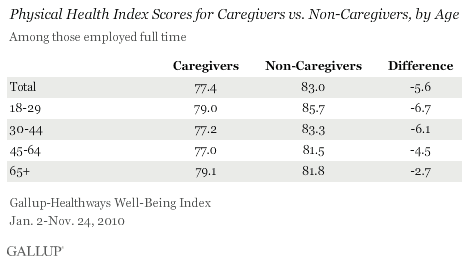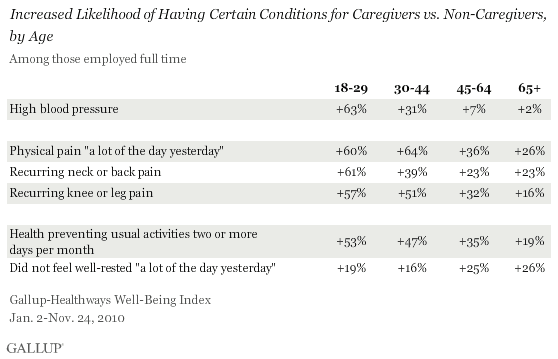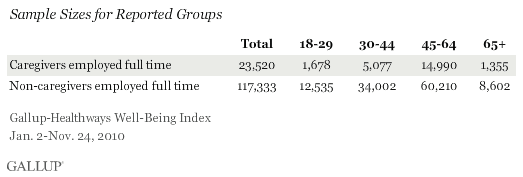This is the second article in a special multipart series on caregiver well-being in America. The first article explored the relationship between caregiving and overall well-being.
WASHINGTON, D.C. -- Americans who work a full-time job and say they care for an elderly or disabled family member, relative, or friend, suffer from poorer physical health than those who work a full-time job but do not have additional caregiving responsibilities. Caregivers, who represent 16% of the full-time American workforce, have a Physical Health Index score of 77.4, which is significantly lower than the 83.0 found among non-caregivers.

As with overall well-being, working Americans between the ages of 18 and 29 suffer the physical effects of caregiving more than any other group, followed closely by 30- to 44-year-olds. Americans younger than the age of 30 have characteristically better physical health than those in other age groups, but this advantage is largely erased among those who fulfill a caregiving role. The difference in physical health between working caregivers and non-caregivers declines as Americans get older, with the smallest affect found among those aged 65 and older.
These findings are based on 140,853 interviews with American adults employed full time conducted Jan. 2-Nov. 24, 2010, as part of the Gallup-Healthways Well-Being Index. Of these respondents, 23,520 self-identified as caregivers based on their response to the question "Do you currently help care for an elderly or disabled family member, relative, or friend, or not?"
Six percent of caregivers who are employed full time are aged 18 to 29, 22% are aged 30 to 44, 65% are between the ages of 45 and 64, and 6% are aged 65 and older.
The Gallup-Healthways Well-Being Physical Health Index comprises 18 items measuring chronic conditions and daily ailments.
Caregivers More Likely to Have High Blood Pressure, Physical Pain
Caregivers employed full time across all age groups, but particularly those younger than 45, are substantially more likely to experience various common physical health issues than their non-caregiving counterparts.
Adult caregivers younger than 30, for example, are 63% more likely than non-caregivers to have high blood pressure and are 61% more likely to have recurring neck or back pain. Even seniors feel negative effects of caregiving, with caregivers aged 65 and older being 26% more likely than non-caregivers to report daily physical pain.

The act of caregiving, perhaps in conjunction with caregivers' increased likelihood to have physical ailments, also brings with it reduced energy and productivity levels. Caregivers in all age groups are more likely than non-caregivers to report that poor health keeps them from doing their usual activities and that they did not feel well-rested the prior day.
Implications
Caregiving, along with being stressful, oftentimes requires more physical activity than normal, including assisting in transfers into and out of wheelchairs, vehicles, and beds; physical therapy; and daily tasks such as bathing and dressing. Although the specific tasks involved in caregiving certainly differ from situation to situation, it is clear that what is involved is taking a toll on the physical health of those who fill this type of role. While young adults generally enjoy superior physical health compared with those who are middle-aged or seniors, caregiving clearly has a disproportionate negative effect on their health Furthermore, those who self-identify as caregivers are somewhat more likely to come from lower income households, meaning they may have reduced options for acquiring outside care, a scenario that may disproportionately affect the young. Regardless, community and business leaders should note the challenges caregivers face so they can help create support systems to help improve the lives of this high-risk group.
About the Gallup-Healthways Well-Being Index
The Gallup-Healthways Well-Being Index tracks U.S. well-being and provides best-in-class solutions for a healthier world. To learn more, please visit well-beingindex.com.
Survey Methods
Results are based on telephone interviews conducted as part of the Gallup-Healthways Well-Being Index survey Jan. 2-Nov. 24, 2010, with a random sample of 140,853 adults, aged 18 and older, living in all 50 U.S. states and the District of Columbia, selected using random-digit-dial sampling. Of this sample of respondents, one-sixth self-identified as caregivers. Nearly two-thirds of all caregivers are between the ages of 45 and 64.

For results based on the total sample of national adults, one can say with 95% confidence that the maximum margin of sampling error is ±0.6 percentage point. For smaller groups, such as caregivers aged 18 to 29 and 65 years old and older, the maximum error range is about ±3 percentage points.
Interviews are conducted with respondents on landline telephones and cellular phones, with interviews conducted in Spanish for respondents who are primarily Spanish-speaking. Each daily sample includes a minimum quota of 200 cell phone respondents and 800 landline respondents, with additional minimum quotas among landline respondents for gender within region. Landline respondents are chosen at random within each household on the basis of which member had the most recent birthday.
Samples are weighted by gender, age, race, Hispanic ethnicity, education, region, adults in the household, cell phone-only status, cell phone-mostly status, and phone lines. Demographic weighting targets are based on the March 2010 Current Population Survey figures for the aged 18 and older non-institutionalized population living in U.S. telephone households. All reported margins of sampling error include the computed design effects for weighting and sample design.
In addition to sampling error, question wording and practical difficulties in conducting surveys can introduce error or bias into the findings of public opinion polls.
For more details on Gallup's polling methodology, visit https://www.gallup.com/.
